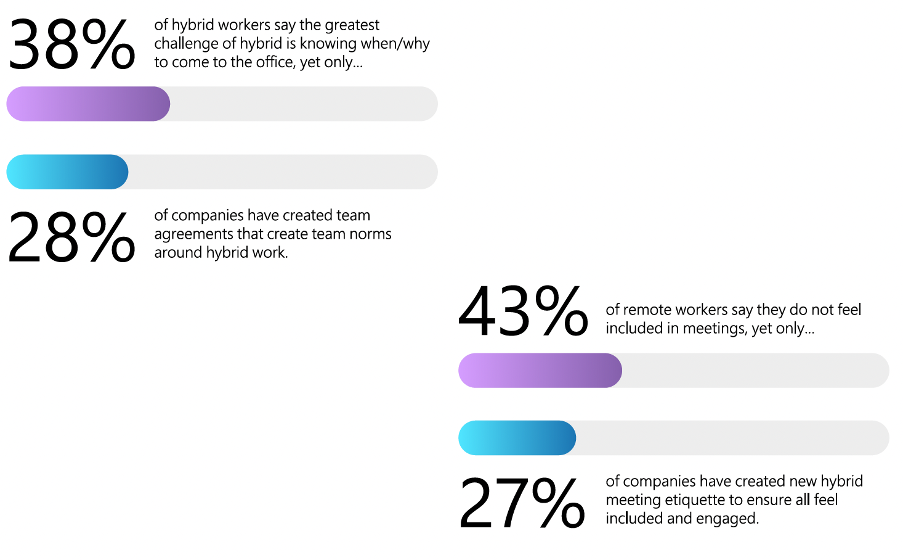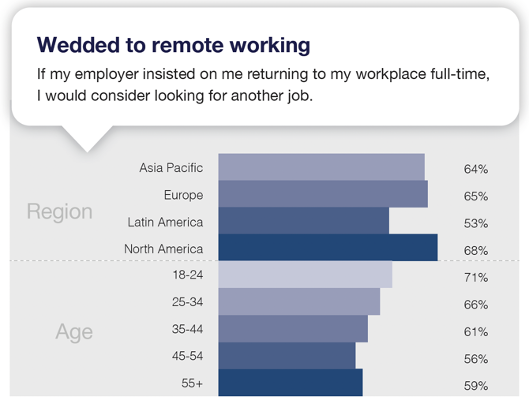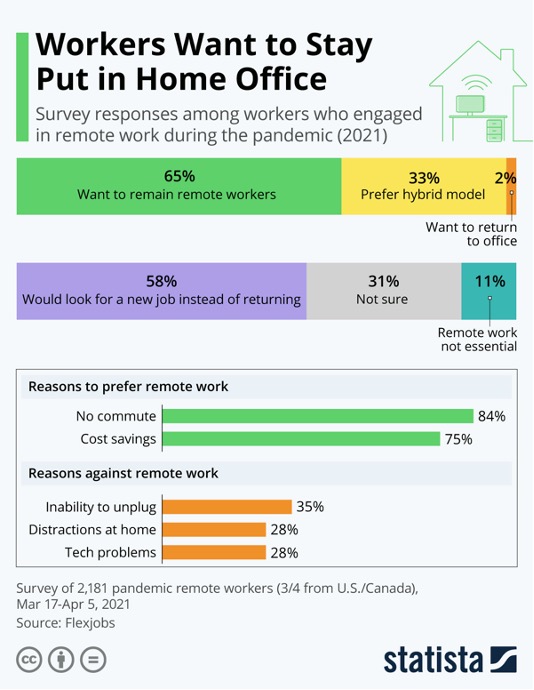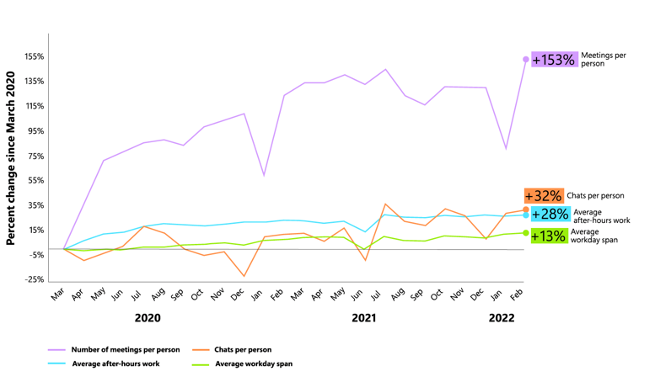
With two years of pandemics, our work habits and needs have changed, particularly the location we work in. What has changed? What do employees now expect, and what do companies need to comply with – despite their worries?
Before the pandemic, home office (working from home) was an option available to very few. Employers in many industries were not sure how to make it work, didn’t know the tools, or were concerned about data security, hence were not very keen on the idea. Employees, on the other hand, weren’t keen to work remotely because they feared, for example, that their personal lives might blend with their professional ones, or that being away from the office would affect their relationships with their employer and co-workers.
Covid-19 changed those rules and – consequently – the attitude toward remote work. These days, as numerous studies have shown, a significant percentage of employees don’t really feel like going back to work in the office full-time. The pandemic has taught us new skills, shown us new opportunities, and we have discovered a tremendous number of digital tools to keep employees productive and committed no matter where they work.
The new standard: hybrid or entirely remote work
Over the past year there have been several studies and reports portraying the way Covid-19 has changed the status quo. According to one of them, over 80% of employees in Belgium claim that they would prefer to work from home at least twice a week, and are willing to come to their workplace for informal meetings (72%) or brainstorming sessions (56%). Furthermore, according to another survey, as many as 64% of survey respondents say they would consider changing jobs if they had to return to their workplace full-time.
Source: People at Work 2022: A Global Workforce View
These results are also supported by other surveys, including those by job search portal Flexjobs. Again, as many as 65% would rather keep working from home, and nearly 3 in 5 respondents would consider changing jobs if they had to return to the office. Only 2% would prefer to return to their workplace full-time in the office.
Employees are also willing to consider hybrid work – a compromise between remote work and office-based work. This is no surprise, especially since as many as 34% of those surveyed have created a dedicated workspace at home.
Source: Statistica.com
Indeed and the OECD reviewed job ads in 20 countries and found that the average share of ads with the possibility of remote work more than tripled (from 2.5% in 2020 to 7.9% in September 2021). There was, needless to say, still concern in many countries about Covid-19 and a possible spread of the disease during the coming fall and winter. In addition, the results varied from industry to industry. Where the employee’s on-site presence is necessary, the rise was the smallest (food preparation, nursing), while in industries based mainly on know-how, such as marketing or software development, the increase exceeded 10%.
A March 2022 report by Microsoft reveals that about 38% of employees worldwide are now working in hybrid mode. This trend is projected to continue and even grow, in particular regarding the younger generations. As stated in the aforementioned report, mobility and flexibility are the cornerstones for younger people, and as many as 58% of Generation Z are considering switching to remote work in the coming year.
There are places in the world where employees are reluctant to work remotely, even though employers are open to hybrid work and switching to hot desk offices. France is the case in point, where people feel a strong bond with their offices and for them the office is, in a way, a token of identity and belonging to the organization.
Japan has a similar attitude toward remote or hybrid work. Employees themselves say that they are less efficient when working from home than when working on-site. In addition, the Japanese prefer to work collectively, and working from home makes it impossible for them to also attend informal conversations and hinders communication in teams. Especially since non-verbal communication, which is harder to achieve through a monitor screen, is a big part of this culture. The size of apartments is also a factor, as well as their price and the fact that very few can afford one in which they can create a comfortable working space.
Pros and risks of hybrid work
Despite countries where working from the office is still more preferred by both parties, in most cases employees want to be able to work fully remotely or hybrid.
What makes employees so eager to switch to remote work mode and not want to give it up? What benefits do they find in it and what do they like about it?
First of all, it saves them time and money by not being forced to commute to the office, which is often far from their homes.
According to the Nofluffjobs website, as many as 60% of respondents claim that working from home has made them feel better, and also more productive. They appreciate more freedom (61%) and more time for themselves (42%).
The respondents of the survey by the Pracuj website mentioned comparable advantages. 66% said that a huge benefit for them was less time spent commuting, as well as financial savings since they did not have to spend money on fuel or monthly tickets. What they also valued was increased efficiency (24%) and the freedom to arrange and choose their own workspace (23%).
Remarkably, as another survey reveals, only 24% of remote workers have a “real” home office, and 34% have a separate dedicated workspace. Being creative in this regard was a major factor in many cases. People converted their closets or garages, while others used their dining table as a work area, and only 9 out of 10 employees spent money to create a home office (42% spent $100-$500, while 12% spent more than $1,000).
Despite the growing popularity of hybrid or remote work, many companies still have concerns and do all it takes to get employees back to their offices. How do employees feel about this?
In the first place, many are still afraid of COVID-19, as well as of losing flexibility and work-life balance. Other concerns about returning to the office include:
- a change in daily routine: 27%
- being away from family or pets: 26%
- office policies and distractions: 34%
- lack of health and safety measures (wearing a mask, maintaining social distance, etc): 32%
- being required to follow health and safety rules: 21%
We have named numerous positives of hybrid work and reasons why employees may not want to return to their offices. But what are the risks of entirely remote or hybrid work, and what are the downsides that should be discussed?
Many respondents, as mentioned in the previous paragraphs, find it difficult to keep their personal and professional lives apart. The number of unpaid hours is entering a disturbing phase. There can be even more than 8 in a week. However, the employer is not to blame here, but rather the fact that the two areas of life are blending.
The other frequently mentioned downside of remote work is too little interaction with their colleagues. According to a report by Microsoft, only half of remote workers believe they have a thriving relationship with their team. This is a major challenge for leaders, as social capital and a sense of belonging are extremely critical factors behind the success of an organization. Good relationships with co-workers not only drive engagement and better performance, but also a better sense of well-being. Employees who joined teams during the pandemic struggle in this area. As studies show, they have poorer relationships with their team and are more willing to change jobs.
Both groups, long-tenured employees and new hires, are likely to face loneliness and a lack of support from team members when things go wrong. This makes it even more important for managers and leaders to look for solutions that promote relationship building and cultivate a culture of support and a sense of security. Specific solutions are difficult to provide here, as much depends on the type of business, the organizational structure and the employees themselves. For sure, discussions and joint efforts to try new ideas are worthwhile.
It might seem that the solution would be to hold informal online meetings, but here you need to be careful, as this increases the number of meetings per day and the number of hours spent in front of the computer.
Source: 2022 Work Trend Index: Annual Report
 Source: 2022 Work Trend Index: Annual Report
Source: 2022 Work Trend Index: Annual Report
Obviously, video meetings have cons, but also a lot of pros. Some of the most commonly mentioned advantages of online meetings include:
- no need to travel to the office for a meeting: 75%
- the possibility of wearing comfortable clothes: 58%
- less office policies: 42%
- they are more efficient: 42%
- the meetings can be recorded: 40%
- more people can be invited: 30%
- being able to see colleagues and customers in a more natural environment: 29%
Speaking of the risks of remote work, we should particularly note the deterioration of mental health. As many as 56% of remote workers surveyed experienced job burnout during the pandemic. This was certainly influenced not only by remote work per se, but also by fear for their own and their loved ones’ health related to the risk of being infected with the Covid-19 virus.
The Dailyfruits report reveals that 21% of respondents felt depressed and frustrated due to the remote work, 19% of respondents indicated loneliness as the dominant emotion, and 11% declared that remote work is a source of stress for them. As many as 85% of respondents pointed out that they miss face-to-face interactions with their peers, 78% miss hanging out over a cup of coffee, and 68% miss the atmosphere of working in an office.
In turn, the article „The influence of COVID-19 pandemic on the remote work – an employee perspective”, listed the lack of direct contact with colleagues (69% of respondents) among the most negative consequences of remote work during the pandemic, and the lack of social contact and isolation as the major difficulty, which, due to the inability to build informal relationships, also created obstacles to completing assigned tasks, created a sense of isolation, loneliness and alienation.
Another issue is additional costs and having to use private space for work purposes. There are also difficulties in dealing with technology issues (28%) and unreliable WiFi (26%).
Although many studies show that remote and hybrid work do not affect efficiency to a great extent, as we mentioned earlier, there has been a drop in efficiency by an average of 20% in Japan (research by economist Toshihiro Okubo).
Remote work has consequences and also affects leaders and managers who are not always able to cope with the new reality. And after all, they are the ones who are expected to be good managers and leaders. According to the “2022 Work Trend Index: Annual Report,” many of them feel helpless and believe they are failing to meet employee expectations.
Remote work vs. the law
Another indication of the significance of remote work is the involvement of governments in regulating the matter in labor law. While many countries around the world have been adopting changes to labor laws related to remote work for years (e.g., in France, the right “to disconnect,” i.e., not to answer emails and phone calls outside working hours without consequences, came into effect in 2016), Covid-19 has accelerated and further expanded these efforts.
In Spain, for example, a new Royal Decree regarding the remote work framework was adopted in September 2020. It states that all remote work arrangements are to be contractually and voluntarily written down.
Poland, in turn, is working on an amendment to the Labor Code, which is expected to be released this fall. As announced by the Ministry of Labor and Social Policy, the amendment is expected to not only provide a definition of remote work but will also define the rights and obligations to be borne by the employee and the employer.
The Norwegian government has amended the current law to require that regulations concerning working hours, Sunday and night work are also to be applicable to employees working from home. In addition, the Norwegian Labor Inspectorate is to be authorized to supervise compliance with home office regulations – officials will not be able to conduct inspections at home, but the employee will be required to provide adequate documentation to prove compliance.
These are just a few examples of efforts toward adapting labor laws to new realities and the needs of both employees and employers.
Globalization of work and digital nomadism
The pandemic has also caused many people (52%) to consider moving to another country. Employers, in turn, have become even more open to hiring foreigners and people living abroad. For many industries, this is a tremendous opportunity to attract new talents and accelerate the growth of many industries.
Digital nomadism, something that started becoming popular even before the pandemic, has now gained momentum. In this area, countries will face the challenge of adjusting regulations to facilitate this trend. At present, it’s often a gray area, with as many as 11 European countries banning remote work for non-residents, 23 countries allowing remote work for only a few days if it’s related to the main purpose of residency, and only three countries allowing remote work as the main purpose of residency for a limited period of time.
There are other types of restrictions, like in Iceland, where candidates for a digital nomad visa must prove that they earn at least €7100 per month. Taxes are another obstacle; different countries have different tax regulations. Often a tourist or nomad visa does not exempt you from local income tax laws. In many cases, a stay longer than 6 months involves applying for tax residency and paying income tax in that country.
A long-lasting shift in paradigm or just temporary fuss?
What’s the future for remote work, then? How to balance employees’ expectations for flexibility and mobility with concerns about relationship-building and drop in productivity at the same time?
There is no single answer to this. Unfortunately. Each company should analyze this issue internally, considering the specifics of its industry and the benefits and risks of remote work. At this point, hybrid work seems to be the optimal solution, which will make it easier for managers to adapt to the new reality, while the employees, in turn, will enjoy not only greater mobility, but also tangible proof of confidence in their responsibility and professionalism. Hybrid work may also be the answer to the ever-growing concerns about employees’ mental health and overall well-being. The long-term impact of full-time remote work on mental health and social skills is sure to be studied in the years to come










